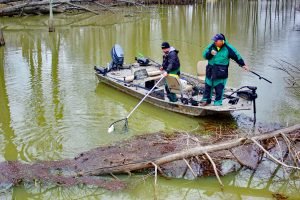Crappie anglers, including author Keith Sutton, love fishing during the spring spawning season when dozens of
fish can be caught in shallow water along the shores of lakes throughout the country. (Photo: Matthew Sutton)
Crappie Spawn Preview: What to Expect and How to Prepare
by Keith Sutton
While the dates will vary some, depending upon where you live, Spring marks the crappie spawn – a time when America’s favorite panfish lure anglers to the water in droves. All are dreaming of the promise of easy catches and full coolers. When the call goes out, “The crappie are bedding,” fishermen and women grab their gear to enjoy some of the year’s best fishing action.
One thing to remember, however, spawning time is always spread out, usually over a three or four-week time frame. It’s called a “Bell Curve” on a graph. There will be a few days, maybe a week, when the largest number o0f crappie are spawning, but there are always some fish before and after that peak spawning.
The folks who are out there on the front end of that bell curve, and stick around after the bell curve, are the ones who will reap the highest rewards. Some say that, “If you wait until you hear the fish are biting, you’ve probably already missed the best part of it.”
Spring: Crappie Frenzy
Several factors contribute to the red-hot fishing of the crappie spawn.
Before the actual spawn begins, male and female crappie go on a feeding frenzy to compensate for their energy-draining reproductive growth spurt. This makes them easier to catch.

When spawning peaks, crappie concentrate in the shallows, often gathering in dozens of nests within a small area. This density not only makes them easier to locate but also boosts anglers’ odds of success.
Male crappie defend their nests fiercely, chasing away egg predators or anything perceived as a threat. Many crappie are caught during this time, not because they’re hungry but because they’re striking at intruders. This aggression continues for a week or more after nesting ends, extending the fishing bonanza.
Timing the Spawn
Water temperature is the primary trigger for crappie spawning. Nesting typically begins when the water reaches 56 degrees, with peak activity occurring between 58 and 60 degrees.
Because these temperatures vary depending on location and weather, anglers need to monitor local conditions closely. Be ready to hit the water when the shallows start to warm.
Sunrise-sunset tables can also help pinpoint peak spawning times. As fisheries biologist Dr. Fred Vasey found in a study on Missouri’s Table Rock Lake, spawning begins when daylight averages 13.2 hours and ends around 14.6 hours. By tracking the number of daylight hours, you can estimate when crappie will be bedding in your area.
Targeting Spawning Fish
Male crappie create nests by fanning away silt with their tails, exposing gravel or plant-root bottoms, often near logs or other cover. These nests cluster in shallow, wind-protected coves, and a single cove can hold dozens—a jackpot for anglers who locate them.
To pinpoint hotspots, study a bottom contour map. Look for underwater creek channels leading to shallow areas, as crappie use these paths to migrate. The backs of feeder-creek bays and shallow areas near stumps, fence lines or weed beds also provide ideal spawning conditions. The key combination is shallow water with abundant cover and a firm bottom.
Proven Tactics
For best results, use small jigs or live minnows near cover such as brush piles, logs or submerged trees in sheltered coves. As crappie are removed from a bed, others move in, keeping the action steady. The same spots often produce year after year, so take note of productive locations.

Whether fishing from a boat or the bank, a long pole allows precise placement of your bait. A lightweight jigging or cane pole works well, especially if you’re dropping bait near dense cover. If using minnows, hook them lightly through the back or lips and add a small split shot to sink them into the strike zone.
A small bobber can be invaluable, signaling even the slightest bite. For jigs, tie the knot at the top of the hook eye so the lure hangs horizontally, mimicking a minnow. Cast the rig near cover, let it sit, and be ready—if a crappie is nearby, your bobber won’t stay still for long.
Tips for Big Crappie
During the early stages of the spawn, larger crappie often remain in deeper water, while smaller males prepare the nests. Savvy anglers target deeper zones, sometimes as far down as 7 to 15 feet, to catch trophy fish.
Also, as we mentioned earlier, spawning activity doesn’t happen all at once. Even individual female crappie deposit their eggs in batches over several weeks, ensuring reproduction success and providing anglers with weeks of outstanding fishing.
Where you find one crappie, there are likely many more. Fish each area thoroughly, moving your bait or lure just a few inches at a time. Crappie beds can span areas as large as a school bus, each holding dozens of fish. Stay until the bite slows, then move to the next promising spot.
The Reward
The ultimate reward for a day spent chasing crappie?
Fresh, golden fillets that turn your catch into an unforgettable feast. Fillet or pan-dress the fish, coat them in seasoned cornmeal, and fry them until the meat flakes easily with a fork. One bite and you’ll understand why crappie fishing during the spawn is a beloved tradition for so many.
Keith Sutton is editor of our sister magazine at CatfishNOW.com. He’s been an avid crappie angler for more than half a century, pursuing his favorite panfish on waters throughout the United States. His fishing stories have been read by millions in hundreds of books, magazines, newspapers and Internet publications. In 2021, he was inducted into the Legends of the Outdoors Hall of Fame.


